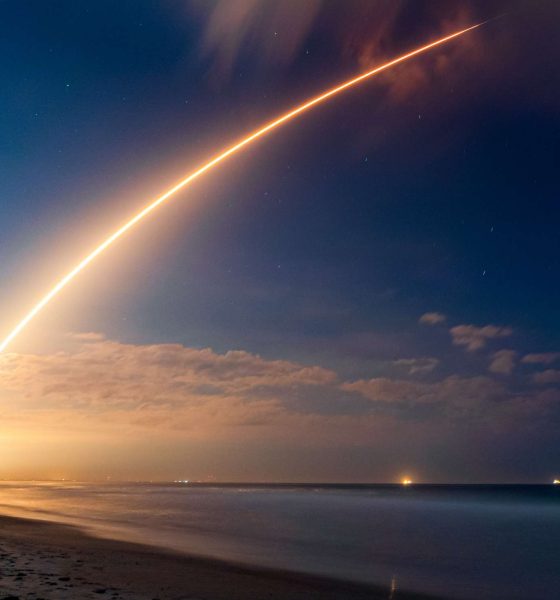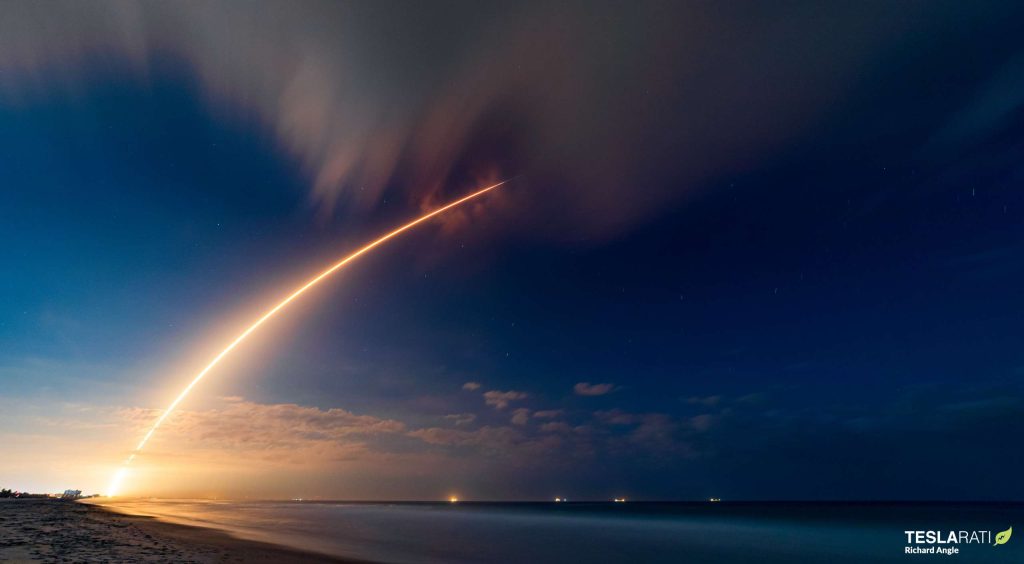

News
SpaceX Starlink Gen2 mission marks Falcon 9 rocket’s 200th successful launch
A day and a half after its 200th launch overall, SpaceX’s Falcon 9 rocket has successfully launched for the 200th time.
Falcon 9 has only suffered two mission-related failures in flight: one partial failure in 2012 and a catastrophic failure in 2015. Falcon 9’s 2015 failure entirely destroyed the rocket and its cargo-carrying Dragon spacecraft before they reached orbit. Its 2012 failure only doomed a secondary Orbcomm satellite payload, while the primary mission – a Cargo Dragon supply delivery for NASA – was technically successful.
Excluding partial failures, Starlink 5-3 was SpaceX’s 200th successful Falcon 9 launch since the rocket debuted in June 2010. Indicative of the company’s aggressive launch cadence as of late, Falcon 9 completed its 200th launch overall (199th success) less than two days prior, on January 31st.
The update that's rolling out to the fleet makes full use of the front and rear steering travel to minimize turning circle. In this case a reduction of 1.6 feet just over the air— Wes (@wmorrill3) April 16, 2024
Starlink 5-3 was SpaceX’s third launch for its Starlink Gen2 constellation, though the mission carried 53 ordinary Starlink V1.5 satellites. Oddly, the Starlink 5-2 mission carried 56 Starlink V1.5 satellites and set a new record for the heaviest SpaceX and Falcon 9 payload on January 26th. Just a few weeks prior, Falcon 9’s Starlink 5-1 launch carried 54 satellites – a curious amount of variability for three missions launching the same type of satellite to similar orbits.
As previously discussed on Teslarati, perhaps the single most important upgrade meant for SpaceX’s Starlink Gen2 constellation was a move to larger V2.0 satellites with almost a magnitude more usable bandwidth. But full-size Starlink V2.0 satellites can only be efficiently launched on SpaceX’s next-generation Starship rocket, which is likely at least 6-12 months away from its first satellite launch. SpaceX also told the FCC that it was building a mid-sized Starlink V2.0 satellite that could be launched on its existing Falcon rockets, but those compromised satellites have yet to appear.
Instead, SpaceX is launching Starlink V1.5 satellites under its Gen2 constellation license, which currently allows the company to launch and operate 7,500 of the almost 30,000 satellites it requested permission for. SpaceX’s Starlink Gen1 constellation is still ~1100 satellites away from completion. One possible explanation is that nearly all of the missing Gen1 satellites are headed to polar or semi-polar Earth orbits. Those polar satellites will spend far more time over regions of Earth with few to no Starlink customers, making them less capital-efficient than their mid-latitude siblings.
In other words, polar Starlink satellites – while necessary to ensure truly global coverage – effectively add less capacity to SpaceX’s network than they would if launched to midlatitude orbits. That appears to be exactly what SpaceX is currently doing with Starlink Gen2. The mid-latitude ‘shells’ of its Gen1 constellation are close to full, so the company is launching Starlink V1.5 satellites under its Gen2 license to increase the capacity of the overall network as quickly as possible.
Eventually, SpaceX will almost certainly replace those smaller, less capable V1.5 satellites with V2.0 satellites. In the near term, though, SpaceX has concluded that an inefficient gap-filler is better than waiting for a more optimal solution. It should not take long for the impact of Gen2 launches to be felt. Once the 163 ‘Gen2’ satellites launched in the last five weeks reach operational orbits, they will increase Starlink’s mid-latitude capacity by more than 5%.


News
Tesla starts showing how FSD will change lives in Europe
Local officials tested the system on narrow country roads and were impressed by FSD’s smooth, human-like driving, with some calling the service a game-changer for everyday life in areas that are far from urban centers.

Tesla has launched Europe’s first public shuttle service using Full Self-Driving (Supervised) in the rural Eifelkreis Bitburg-Prüm region of Germany, demonstrating how the technology can restore independence and mobility for people who struggle with limited transport options.
Local officials tested the system on narrow country roads and were impressed by FSD’s smooth, human-like driving, with some calling the service a game-changer for everyday life in areas that are far from urban centers.
Officials see real impact on rural residents
Arzfeld Mayor Johannes Kuhl and District Administrator Andreas Kruppert personally tested the Tesla shuttle service. This allowed them to see just how well FSD navigated winding lanes and rural roads confidently. Kruppert said, “Autonomous driving sounds like science fiction to many, but we simply see here that it works totally well in rural regions too.” Kuhl, for his part, also noted that FSD “feels like a very experienced driver.”
The pilot complements the area’s “Citizen Bus” program, which provides on-demand rides for elderly residents who can no longer drive themselves. Tesla Europe shared a video of a demonstration of the service, highlighting how FSD gives people their freedom back, even in places where public transport is not as prevalent.
What the Ministry for Economic Affairs and Transport says
Rhineland-Palatinate’s Minister Daniela Schmitt supported the project, praising the collaboration that made this “first of its kind in Europe” possible. As per the ministry, the rural rollout for the service shows FSD’s potential beyond major cities, and it delivers tangible benefits like grocery runs, doctor visits, and social connections for isolated residents.
“Reliable and flexible mobility is especially vital in rural areas. With the launch of a shuttle service using self-driving vehicles (FSD supervised) by Tesla in the Eifelkreis Bitburg-Prüm, an innovative pilot project is now getting underway that complements local community bus services. It is the first project of its kind in Europe.
“The result is a real gain for rural mobility: greater accessibility, more flexibility and tangible benefits for everyday life. A strong signal for innovation, cooperation and future-oriented mobility beyond urban centers,” the ministry wrote in a LinkedIn post.
News
Tesla China quietly posts Robotaxi-related job listing
Tesla China is currently seeking a Low Voltage Electrical Engineer to work on circuit board design for the company’s autonomous vehicles.

Tesla has posted a new job listing in Shanghai explicitly tied to its Robotaxi program, fueling speculation that the company is preparing to launch its dedicated autonomous ride-hailing service in China.
As noted in the listing, Tesla China is currently seeking a Low Voltage Electrical Engineer to work on circuit board design for the company’s autonomous vehicles.
Robotaxi-specific role
The listing, which was shared on social media platform X by industry watcher @tslaming, suggested that Tesla China is looking to fill the role urgently. The job listing itself specifically mentions that the person hired for the role will be working on the Low Voltage Hardware team, which would design the circuit boards that would serve as the nervous system of the Robotaxi.
Key tasks for the role, as indicated in the job listing, include collaboration with PCB layout, firmware, mechanical, program management, and validation teams, among other responsibilities. The role is based in Shanghai.
China Robotaxi launch
China represents a massive potential market for robotaxis, with its dense urban centers and supportive policies in select cities. Tesla has limited permission to roll out FSD in the country, though despite this, its vehicles have been hailed as among the best in the market when it comes to autonomous features. So far, at least, it appears that China supports Tesla’s FSD and Robotaxi rollout.
This was hinted at in November, when Tesla brought the Cybercab to the 8th China International Import Expo (CIIE) in Shanghai, marking the first time that the autonomous two-seater was brought to the Asia-Pacific region. The vehicle, despite not having a release date in China, received a significant amount of interest among the event’s attendees.
Elon Musk
Elon Musk and Tesla AI Director share insights after empty driver seat Robotaxi rides
The executives’ unoccupied tests hint at the rapid progress of Tesla’s unsupervised Robotaxi efforts.

Tesla CEO Elon Musk and AI Director Ashok Elluswamy celebrated Christmas Eve by sharing personal experiences with Robotaxi vehicles that had no safety monitor or occupant in the driver’s seat. Musk described the system’s “perfect driving” around Austin, while Elluswamy posted video from the back seat, calling it “an amazing experience.”
The executives’ unoccupied tests hint at the rapid progress of Tesla’s unsupervised Robotaxi efforts.
Elon and Ashok’s firsthand Robotaxi insights
Prior to Musk and the Tesla AI Director’s posts, sightings of unmanned Teslas navigating public roads were widely shared on social media. One such vehicle was spotted in Austin, Texas, which Elon Musk acknowleged by stating that “Testing is underway with no occupants in the car.”
Based on his Christmas Eve post, Musk seemed to have tested an unmanned Tesla himself. “A Tesla with no safety monitor in the car and me sitting in the passenger seat took me all around Austin on Sunday with perfect driving,” Musk wrote in his post.
Elluswamy responded with a 2-minute video showing himself in the rear of an unmanned Tesla. The video featured the vehicle’s empty front seats, as well as its smooth handling through real-world traffic. He captioned his video with the words, “It’s an amazing experience!”
Towards Unsupervised operations
During an xAI Hackathon earlier this month, Elon Musk mentioned that Tesla owed be removing Safety Monitors from its Robotaxis in Austin in just three weeks. “Unsupervised is pretty much solved at this point. So there will be Tesla Robotaxis operating in Austin with no one in them. Not even anyone in the passenger seat in about three weeks,” he said. Musk echoed similar estimates at the 2025 Annual Shareholder Meeting and the Q3 2025 earnings call.
Considering the insights that were posted Musk and Elluswamy, it does appear that Tesla is working hard towards operating its Robotaxis with no safety monitors. This is quite impressive considering that the service was launched just earlier this year.








